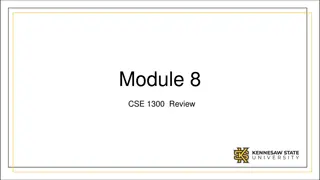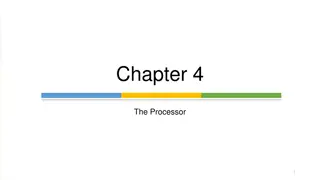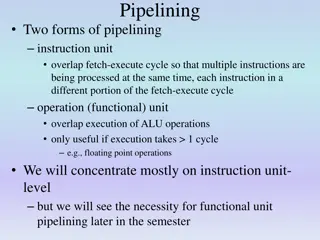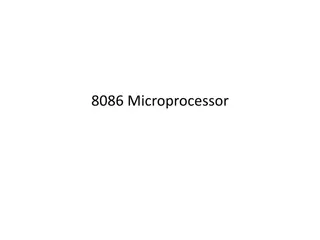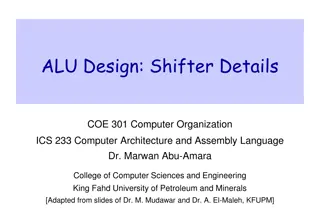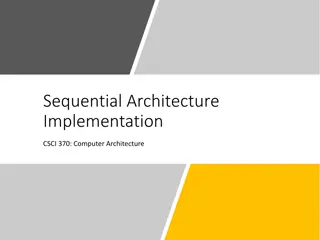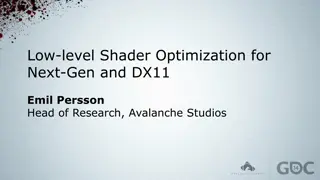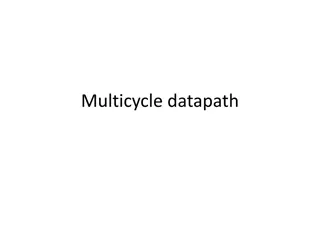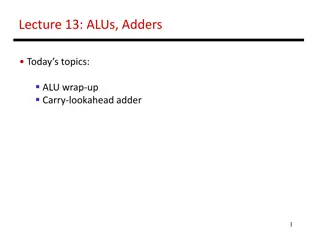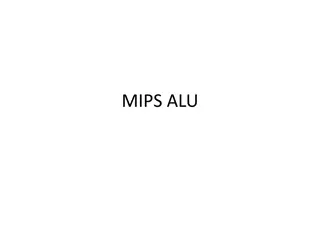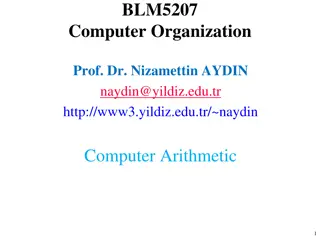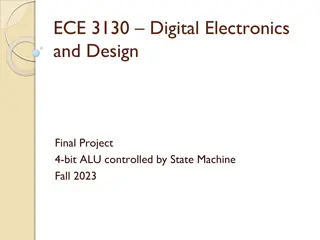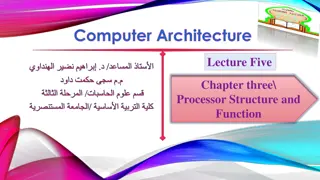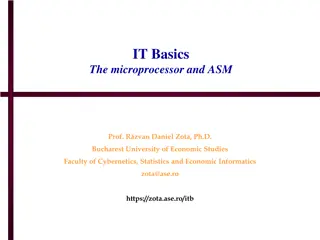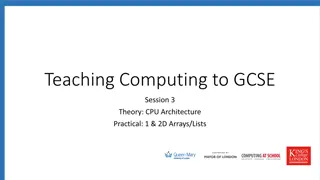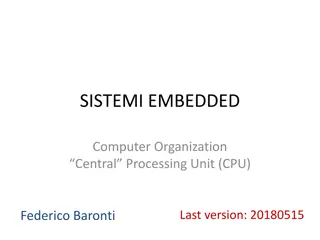Understanding Computer Hardware and Software Fundamentals
A computer is a programmable electronic device consisting of hardware and software that enables input, processing, storage, and output of information. This includes characteristics, basic components, application software, and advanced processing stages like ALU, input/output devices, control unit, R
0 views • 14 slides
Introduction to Components of a Computer System in Home Science
Explore the components of a computer system in Home Science, including input devices like the keyboard, alphanumeric keypads, cursor movement keys, and special keys such as Enter, Ctrl, Esc, and more. Learn about the internal structure of a computer system and the key functions of CPU, ALU, memory,
8 views • 12 slides
Understanding the Basics of Computer Hardware and CPU
Explore the fundamental concepts of information technology, focusing on hardware components like the CPU, control unit, ALU, registers, and cache memory. Learn about the functions of these parts and how they contribute to a computer's performance and speed.
3 views • 37 slides
Understanding Computer Components and Binary Numbers in Computing
Computer components like the case, power supply unit, motherboard, and storage devices play crucial roles in a computer system. CPUs consist of essential parts like the ALU, control unit, and registers. Binary numbers, a base-2 numbering system, simplify data representation and processing in computi
1 views • 44 slides
Understanding the Basics of Computer and Its Components
A computer is an electronic device that processes data input by the user to provide output results. It comprises components like ALU, CU, and MU, each with specific functions. The CPU acts as the brain of the computer, transforming raw data into information. The system's memory units, RAM and ROM, s
1 views • 12 slides
MIPS CPU Design Using Verilog and Instruction Set Architecture Overview
Explore the world of MIPS CPU design using Verilog with a deep dive into Instruction Set Architecture (ISA), SPIM instruction formats, addressing modes, and more. Learn about the key components such as Program Counter (PC), Instruction Memory (IM), Register Files (RF), Arithmetic Logic Unit (ALU), D
1 views • 29 slides
Processor Control Unit and ALU Implementation Overview
In Chapter 4, the processor's control unit and ALU are detailed in a simple implementation scheme. The ALU performs operations based on opcode values, while the control unit provides signals for various functions such as load/store, compare, and branch. Decoding techniques and control signal generat
1 views • 21 slides
Understanding Computer Processing Systems
Computer processing systems consist of various components such as the control unit, ALU, input unit, CPU, output unit, memory, and more. Input devices feed raw data to the computer, while output devices provide processed information. The CPU plays a crucial role in executing instructions and data pr
0 views • 13 slides
Understanding Pipelining in Computer Architecture
Pipelining in computer architecture involves overlapping fetch-execute cycles to process multiple instructions concurrently. It utilizes stages, latches, and throughput to enhance CPU performance. Different forms of pipelining, stage-related terms, and the transition from non-pipelined to pipelined
0 views • 64 slides
Understanding the Functional Blocks of the 8086 Microprocessor
The 8086 Microprocessor is a pivotal component in computer systems, with various functional blocks storing results as status bits called flags in the flag register. It performs arithmetic and logic operations, utilizes registers for data storage, features an ALU for generating addresses and instruct
3 views • 41 slides
Design and Implementation of Shifters in ALU for Single-Cycle Processors
The detailed discussion covers the construction of a multifunction Arithmetic Logic Unit (ALU) for computer processors, specifically focusing on the design and implementation of shifters. Shift operations such as SLL, SRL, SRA, and ROR are explained, with insights into shifting processes and data ex
0 views • 5 slides
Understanding Y86-64 Instruction Set and Hardware Control Language
Delve into the Y86-64 instruction set architecture, exploring sequential architecture implementations for computer architecture. Uncover the various instruction sets and their functionalities, such as halt, nop, call, ret, and more. Additionally, discover the building blocks of hardware, including A
0 views • 51 slides
Insights into Low-Level Shader Optimization for Next-Gen Technology
Delve into the world of low-level shader optimization for the next generation and DX11 with Emil Persson, Head of Research at Avalanche Studios. Uncover key lessons from the previous year, explore modern hardware developments, and grasp the intricacies of sampling a cubemap. Witness the evolution of
0 views • 52 slides
Multicycle Datapath and Execution Steps Overview
This content provides a detailed explanation of a multicycle datapath and the execution steps involved in processing instructions. It covers key elements such as instruction fetching, decoding, memory referencing, ALU operations, branch and jump instructions, as well as memory access for read and wr
0 views • 11 slides
Notion VTec Bhd Business Update Summary December 2020
Notion VTec Bhd provided an update on their N95 respirator certifications, Nitrile Gloves trading and manufacturing projections, and EMS vacuum cleaner Alu tubes contribution. The company has achieved various certifications allowing N95 exports to countries like the USA, Europe, Australia, and Malay
0 views • 9 slides
Understanding ALUs and Adders in Computer Architecture
Explore the concepts of Arithmetic Logic Units (ALUs) and adders in computer systems through topics like ALU operations, 1-bit ALU with Add, Or, And operations, 32-bit Ripple Carry Adder, subtraction incorporation, NOR and NAND operations, control lines for different operations, incorporating slt an
0 views • 19 slides
Understanding MIPS Arithmetic Logic Unit (ALU)
The MIPS ALU is the heart of computer calculations, performing functions like add, and, or, and sub. This article delves into designing a full ALU, starting from a 1-bit full adder to a 32-bit ALU. It explores how operations like and, or, and addition are carried out within the ALU, and how to imple
0 views • 28 slides
Understanding Computer Arithmetic: ALU, Integer Representation, and Twos Complement
Exploring the fundamental concepts of computer arithmetic including the Arithmetic & Logic Unit (ALU), integer representation methods, and the Twos Complement system. Learn about sign-magnitude, characteristics of Twos Complement representation, benefits, negation techniques, and special cases in co
1 views • 57 slides
Digital Electronics and Design Fall 2023 Final Project: 4-bit ALU Controlled by State Machine
This project involves designing a 4-bit Arithmetic Logic Unit (ALU) controlled by a State Machine. The ALU performs operations such as addition, subtraction, resetting to zero, and holding results based on select signals. The system includes input and output D Flip-Flops (DFFs) with clear pins, MUX
0 views • 14 slides
Understanding Processor Organization in Computer Architecture
Processor organization involves key tasks such as fetching instructions, interpreting instructions, processing data, and storing temporary data. The CPU consists of components like the ALU, control unit, and registers. Register organization plays a crucial role in optimizing memory usage and control
0 views • 21 slides
Understanding Microprocessor Architecture and Instruction Processing
Explore the basic architecture of a microprocessor, including CPU registers, memory locations, and instruction processing steps. Learn about Intel microprocessor components, addressing modes, and the operation of pipeline microprocessors. Understand the role of control units, ALU, and bus interfaces
0 views • 38 slides
Understanding CPU Architecture in Computing for GCSE Students
Explore the fundamental concepts of CPU architecture, including the Von Neumann Architecture, common CPU components like ALU and CU, and how characteristics such as Clock Speed and Cache Size impact performance. Learn about the Fetch-Execute Cycle and the essential hardware components of a computer
0 views • 18 slides
Understanding the Basics of Multi-Stage Architecture in CPU Design
The article explains the fundamentals of a multi-stage digital processing system in computer organization, focusing on the central processing unit (CPU). It covers topics such as instruction execution, processor building blocks, and the benefits of pipelined operation. Concepts like fetching, decodi
0 views • 42 slides



